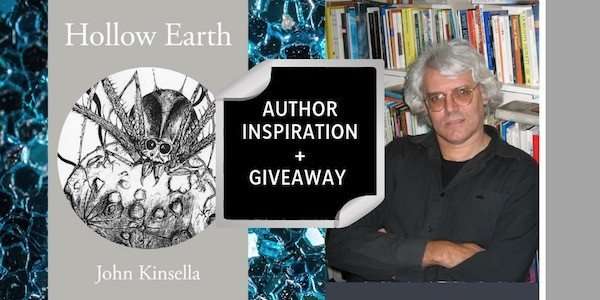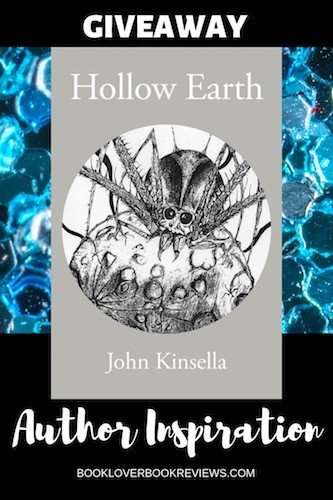John Kinsella’s inspiration for HOLLOW EARTH
Today we welcome John Kinsella to Booklover Book Reviews to discuss his new novel Hollow Earth, PLUS we have 2 ebook copies to giveaway in celebration of this title’s release thanks to Transit Lounge Publishing.

Hollow Earth Synopsis:
Fascinated by caves and digging holes since childhood, Manfred discovers a path through to another realm via a ‘Neolithic’ copper mine at Mount Gabriel in Schull, Ireland. The world of Hollow Earth, while no Utopia, is a sophisticated civilisation. Its genderless inhabitants are respectful of their environment, religious and cultural differences are accommodated without engendering hate or suspicion, and grain, not missile silos are built. Yet Ari and Zest accompany Manfred back to the surface world. ‘Come with me and see my world.’
So begins an extraordinary adventure in which the three wander the Earth like Virgil’s Aeneas, Ari and Zest seeking re-entry to their own world. The Hollow Earthers are shocked at the cruelty and lies of the surface world, the dieback spreading through the forests. Yet they are seduced by the world’s temptations.
Kinsella’s parable draws on a rich tradition of Hollow Earth literature and science fiction including Bradshaw’s The Goddess of Atavatabar (1892). With strange beauty, its alluring trajectory vividly captures our 21st-century world in crisis. Like Manfred, we are often blindly complicit in the earth’s downfall. ‘Happiness is under our feet.’ sings the narrator in this passionate, layered and compelling new novel.
‘Combining a twenty-first century sense of planetary peril with a 1970s funkadelic vibe, Hollow Earth reaches to the extremes of our collective breath, its alpha and omega … This is a novel of exacting self-scrutiny which also manages to be outrageous fun’ — Nicholas Birns
(Transit Lounge Publishing, September 2019)
~
Disclosure: If you click a link in this post we may earn a small commission to help offset our running costs.
The Inspiration Behind Hollow Earth
by John Kinsella
Ideas and concepts for books brew with me for a long time, sometimes a very long time. Hollow Earth is part of a series of interconnected ideas that are becoming speculative novels and novellas that oscillate around questions of justice and consequence in terms of how we are treating the biosphere and the entire planet, from its ‘core’ through to its place in the solar system and beyond.
These works are largely a kind of realist speculative fiction/s, that deal with immediate environmental, social and political justice issues in unusual often bizarre and ‘sci-fi’-like scenarios. It’s the tension and crossover between literary and ‘popular’ genres that interests me. I am making stories out of concepts and ideas, but against backdrops of a gritty realism of the damage being done to the planet, and to all life by humans, including humans to humans. These are fictions which play with time and space to offer alternative ways of focussing on the here and now. They are stories of consequences.
Hollow Earth dialogues with a lot of other literature, especially Jules Verne’s Journey to the Centre of the Earth (also with the first film version of this!), and other ‘hollow earth’ works, especially William R. Bradshaw’s clunkily written bizarre Goddess of Atvatabar with its appropriative and strange linguistic plays and exploitations, and its variation on Western colonial ‘explorer’-risk-at all costs in the name of ‘knowledge’ and science motifs.
What is inside the earth inflects what’s on its outside, and we wear the interior like a conscience — we unearth what we could be, what we are, what we might have become. Exploration has consequences. I wanted to write out of and against the colonising impetus of these genre narratives. I wanted to write a book against the tyrannies of gender control. I wanted to challenge big business and mining rapacity. I wanted to deal with addictive behaviours. I wanted to challenge the closing of borders to refugees, the tyranny of centralised government. I wanted to imagine environmental ‘technologies’, and not praise technology as something valuable in itself, something to profit from. I wanted to imagine versions of non-nuclear families and adaptive relationships. I wanted to consider a different ‘science’ of nature and ‘behaviourism’. I wanted to escape chronologies, and work in the future and the past in the present. Discussing these ideas in fiction goes back to my first science fiction novella written when I was fifteen (long ago and long lost!).
 Hollow Earth started life as a more conventional narrative and became what might be called a cascading series of vignettes that compel a story.
Hollow Earth started life as a more conventional narrative and became what might be called a cascading series of vignettes that compel a story.
It’s a quest novel — a compulsion to discover drives the story, but the discoveries have consequences.
It’s a novel about love and addiction, and about the need to find a way back home. It’s a novel asking questions about the very nature of ‘home’.
If I had to sum up in a nutshell the ‘inspiration’, I would actually say it comes out of the disgust I developed when I worked on the periphery of the mineral sands industry (in laboratories, preparing samples, supervising the loading and sampling of ships) when I was still a teenager. And maybe the coalescing, gelling idea came when I drew this experience together with my childhood tendency to dig (dangerous!) tunnels, my fascination with visiting caves, and then later, strangely, a visit to the mine shafts at Sovereign Hill, Ballarat, when we were driving ‘East’ from the Western Australian wheat belt in 2012. But the first words on paper came the next year when we were living below the ‘Neolithic’ copper mines of Mount Gabriel, in West Cork, Ireland.
From there, the novel coalesced through the ‘traditions’ of hollow earth literature, and my ethical and political concerns… as well as a fair dose of imagination, which for better or worse, I’ve always had to excess. I am fascinated how life experience and imagination play off each other, and am sure, in the end, this is what fiction-making is about.
Hollow Earth by John Kinsella is available from:
Booktopia(Aus) | Angus&Robertson | Transit Lounge
About the Author, John Kinsella
John Kinsella is the author of over thirty books. His many awards include the Australian Prime Minister’s Literary Award for Poetry and the Victorian Premier’s Award for Poetry. His most recent works include the poetry volumes Drowning in Wheat: Selected Poems (Picador, 2016) and Open Door (UWAP, 2018). Story collections include Crow’s Breath (Transit Lounge 2015) and Old Growth (Transit Lounge, 2017). Recent novels are Lucida Intervalla (UWAP, 2018) and Hollow Earth (Transit Lounge, 2019). He often works in collaboration with other poets, artists, musicians, and activists. He is a Fellow of Churchill College, Cambridge University, and Professor of Literature and Environment at Curtin University, Western Australia.
Worldwide eBook Giveaway
Thanks to Transit Lounge Publishing we have 2 ebook copies of Hollow Earth to giveaway. Open worldwide, entries close midnight 21 September 2019. You can improve your chance of winning by:
- retweeting this Tweet
- sharing this Pin with your followers on Pinterest ; and
- sharing this Facebook post (incl. entry link) with your Facebook followers
The lucky winners will be randomly selected and announced on our Facebook Page.
SORRY, ENTRIES CLOSED — See winners announcement.
